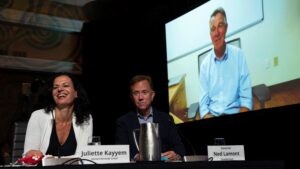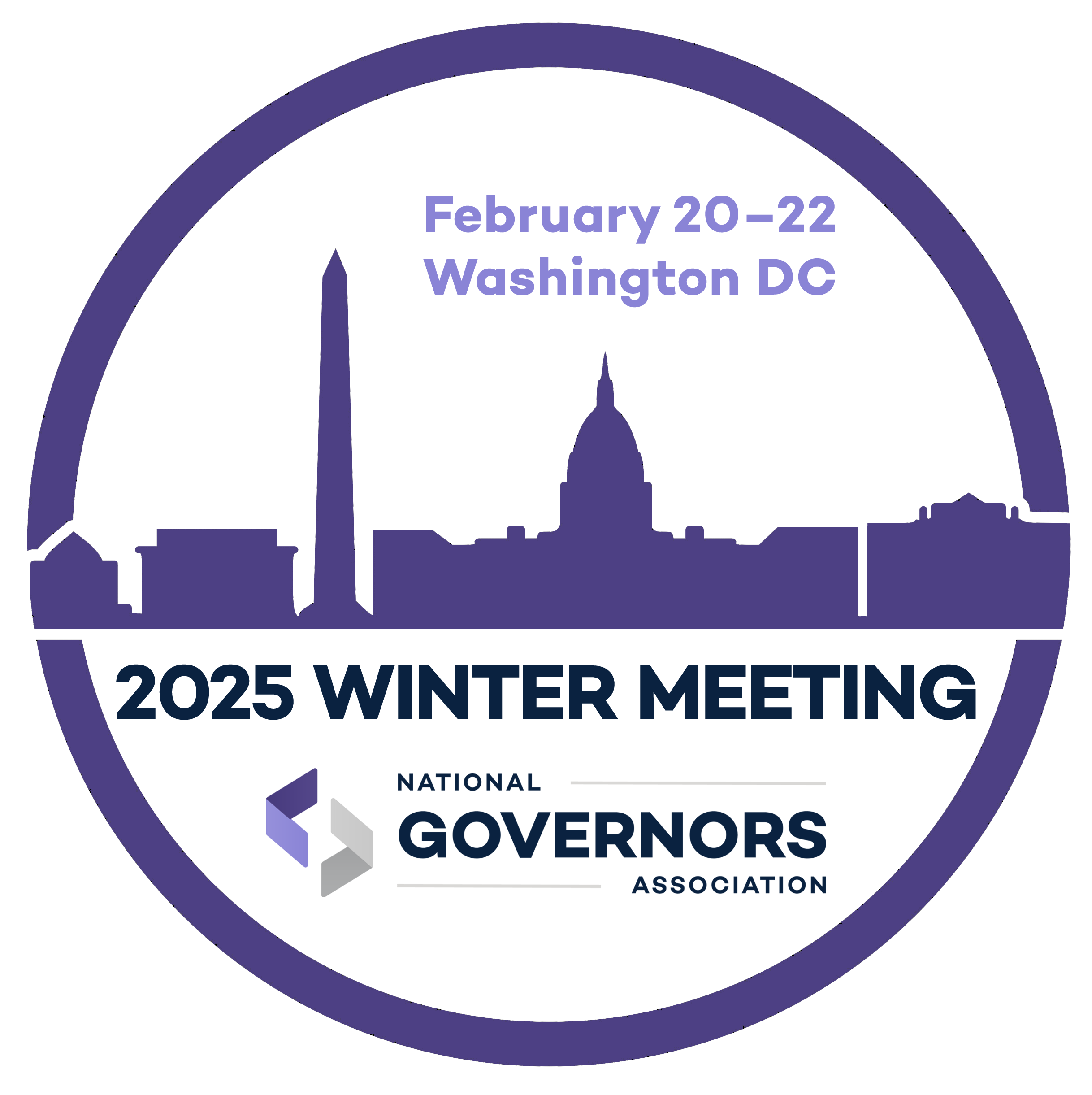At the 2023 NGA Annual Meeting, Connecticut Governor Ned Lamont and Vermont Governor Phil Scott, Co-Chairs of the Public Health and Disaster Response Task Force, hosted a policy discussion on how Governors can prepare for and respond to concurrent crises.
The discussion was part of NGA’s Public Health and Disaster Response Task Force, one of NGA’s three Governor-led task forces designed to foster a collaborative environment for Governors to focus on NGA’s top federal priorities. The Public Health and Disaster Response Task Force has jurisdiction over areas including the Federal Emergency Management Administration (FEMA), National Guard, cybersecurity, health care, immigration, human services, nutrition and COVID-19.
The session featured a conversation with Juliette Kayyem, Belfer Senior Lecturer in International Security at the Harvard Kennedy School, and author of The Devil Never Sleeps: How We Live in an Age of Disasters.
Governor Lamont kicked off the meeting by welcoming Governor Scott, who joined the meeting virtually, as he remained in Vermont to address the flooding crisis impacting the state over the last several weeks.

Governor Lamont noted the amount of new and repeating disasters states have faced over the past several years, including COVID-19 and cyberattacks, and focused on how Governors have had to learn to work together to manage said disasters effectively. “A lot of people can determine what battles they want to take on, but as Governors, the battles come to us … We had to learn how to work together not just across disciplines within our own state, but throughout the entire region and the country as a whole, and that’s something that we’ve got to continue going forward.”
Governor Scott started off by giving an update on the efforts in Vermont to resolve the ongoing flooding crisis. He also thanked Governors who had offered support over the week in aiding Vermont with disaster relief, noting that Swift Rescue Teams from six states had made more than 200 rescues.
He further noted the unique and crucial role that Governors play in preparing for and managing disasters, especially given the frequency and wide range of disasters seen today. “State governments have to be ready for anything and everything, and we have to react to increasing numbers of unpredictable challenges like the one we’re facing in Vermont right now … Every Governor comes face to face with multiple crises, but today the pace of these incidents, and therefore the number of responses, is increasing.”
Governor Scott concluded by emphasizing the need to develop new strategies for disaster response, noting that conversations like the one taking place at the NGA Annual Meeting, are crucial in this effort.
Governor Scott then introduced Juliette Kayyem, who set the stage by discussing the current state of disasters in the country and the need for states to think differently about how they prepare for, manage and mitigate disasters. Using the term “poly-crisis,” Kayyem noted that “there are lots of bad things happening simultaneously, not defined by any one particular threat. The way we think about that is multiple overlapping shocks. The whole is more dangerous than the parts.”
She also emphasized the need for a new Emergency Framework for states, noting that “the State Emergency Management Framework was built in the 1990s and has not had tremendous reform despite the things that keep changing. The framework was based on the notion that disasters were random and rare. Crises are no longer binary, they’re circular and Governors’ teams, through no fault of their own, are ill-equipped and understaffed for this ‘circle of mayhem’.”
She offered six tips for how Governors can play a significant role in effectively managing a crisis:
- Maintain situational awareness at the moment of the “boom.”
- Maintain strong communication with impacted communities and do not delegate knowledge of what’s going on to others. Stick to the facts and relay what the numbers show. “Your role is hope.”
- Remain strategically oriented to help guide communities between the period of immediate disaster response and disaster recovery.
- Implement a state disaster recovery office and think long term about community recovery after the media attention and cameras have left.
- Conduct an after-action review to study what happened to better prepare for future events.
- Incentivize resilience and mitigation planning.

Expanding on her last point regarding mitigation planning, she offered several state examples for Governors to consider implementing in their own states. For example, Alabama has partnered with their state universities on mitigation planning efforts and is working with insurance companies to lower premiums in the event of a disaster. Similarly, Louisiana has implemented a grant mitigation fund that the state is driving to at-risk communities.
At the federal level, she noted several promising developments that states should be aware of including the large amounts of mitigation funding included in the Farm Bill and changes at the Federal Emergency Management Agency that allow for additional mitigation funding for states, including:
- The creation of the Community Disaster Resilience Zone, which steers money to in-need communities following a disaster.
- Changes to the Stafford Act now stipulate that the federal government will cover up to 85% of mitigation funding for impacted communities.
Kayyem further recommended that Governors consult with insurance companies to determine what they need in terms of reducing risk for communities.
In closing, she noted the leadership states and territories have in developing new best practices for disaster response, saying “I think the new playbook is being written by the states and the territories as you recognize that these disasters are not random and rare, that the devil never sleeps and you all are faced with these challenges.”
During a question-and-answer session, Governors shared some of the challenges facing their states and discussed potential solutions with Kayyem.
Connecticut Governor Ned Lamont
“Let’s keep going on the insurance companies if I could. I don’t want them on the sidelines pricing risk, I want them at the table. We got a fair amount of infrastructure money and resilience money. I want them to use their analytics to help us where that could best be deployed. What are other states doing? What could the federal government do to help there?”
Kayyem responded: “I think what’s happening in California and Florida is the insurance companies are trying to get a little more receptivity. California has a rule now that does not let the insurance companies adapt to changing mapping. And you know, you either believe in mapping as a tool to drive resources or you don’t. Now, you might not like what insurance companies are saying, but in the absence of us doing it better, they’re going to fill that vacuum, and they’re going to decide to exit areas where they cannot get enough flexibility. The decisions of where we live, how we live, whether you should live there – you don’t want those decisions made by the private sector, and that’s what’s happening now. So it’s important to bring insurance companies to the table and figure out what they need in terms of mapping. Now of course no one behaves well in the context of all of this, and people go to their corners. But I think that’s where you come in is that you know this is happening, we can’t pretend like it’s not happening. Our public policy is being set by insurance in certain ways or by disaster relief funds that aren’t doing anything to make these communities safer for the future.”
Colorado Governor Jared Polis
“Let’s talk about federal and FEMA for a moment. My frustration is that very often [FEMA’s] solutions are out of touch with what’s needed, and in fact cost federal taxpayers more … In your opinion what should we be asking for in terms of reforming FEMA and a better federal response?
Kayyem responded: “Their hands are legitimately tied. It’s frustrating because everyone knows what needs to be done, but as I said, this was built in the 1970s and it’s just not working anymore. Some of these pushes are happening at the FEMA level, but your Homeland Security advisors, as you know, meet us on a consortium, and one of their number one policy agendas is the Stafford Act. Everyone knows it’s not working. You’re Governors, your access point is the President, so your emergency management teams know what to ask for in terms of FEMA and what FEMA is capable of doing, but there [are] a tremendous amount of federal resources outside of FEMA that you can draw on through the President and his team. The White House takes that seriously, but the White House is the access point. The second thing I would say is from your perspective, to have a good understanding of what resources are available to you from FEMA and the FEMA region that you’re in.”
Puerto Rico Governor Pedro Pierluisi
“One thing that is hard for me is handling communities that are located in flawed areas. What do you do? You cannot start expropriating all over the place, and so it’s a safety issue, and that’s hard. FEMA is doing a couple of things I think that incentivize those constituents to move. FEMA gives them emergency public assistance, but they kind of warn them next time around they won’t be around to help. Another thing we’re working on is the permanent projects in Puerto Rico. A lot of them are being done under Stafford Act section 428, and that section gives you more flexibility in structuring, changing the projects once you’re funded, but FEMA sets a hard cap on the project, and I inherited estimates that were done in 2019. This is 2023; inflation is a concern for how much of the project will actually be funded. So I’m trying to convince FEMA to adjust those caps based on justified inflation.”
Kayyem responded: “I don’t think FEMA would disagree with you. The reforms that have to take place in the doctrine that they’re tied to are going to have to come from you, their constituents. That’s where your Homeland Security advisors are really pushing too to get the Stafford Act to make more sense. And to your first question, it’s very hard to get people to move away from their communities, but if we can get money and incentives, it may be possible to get people to do that. You know people love their children, and they want to protect them. But it’s far off as a public policy right now. But there are ways to incentivize as more resiliency on an individual and community basis, which is what we’re going to need to do.”
Delaware Governor John Carney
“Several of us here in this corner were in Congress a few years ago, and we had an issue of the pricing of flood insurance, and it was very controversial because the people living in dry areas were subsidizing people that were living in these flood-prone areas. Where do you see flood insurance at the national level?”
Kayyem responded: “The National Flood Insurance program is underfunded and has been in debt. We are behind where the climate is taking us. In fact, in Vermont I would bet that most of those people do not have flood insurance. One of the reforms to think [about] is a national safety net of catastrophic or disaster insurance that will cover people who cannot get private insurance. To me that’s the only long-term solution at this stage.”
Bringing the session to a close, Governor Lamont thanked Juliette Kayyem for her time and re-emphasized the importance of strong communication amongst Governors to find solutions.
Learn more about the Public Health and Disaster Response Task Force













